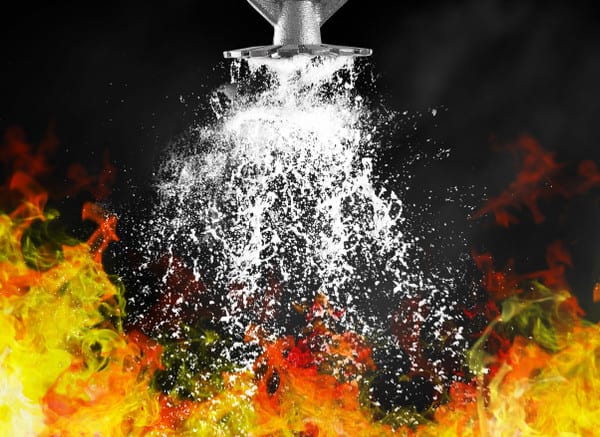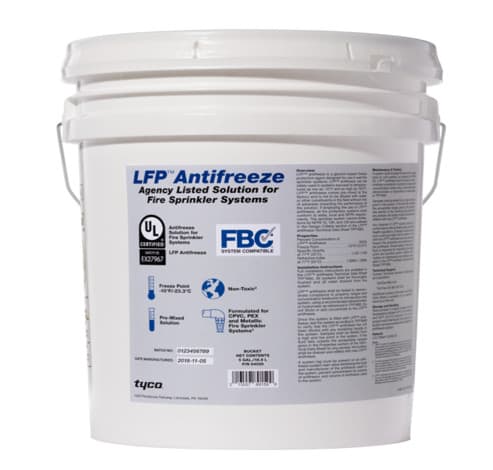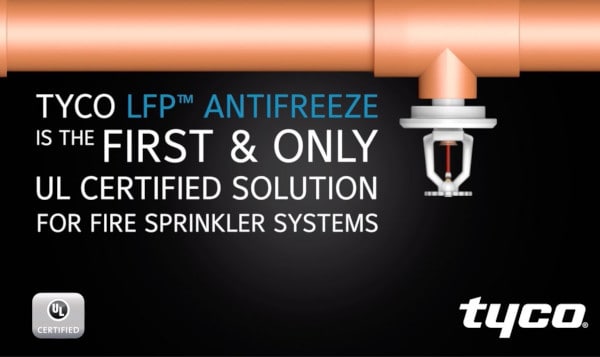Tyco LFP is the first listed antifreeze since flammability concerns caused a phase-out of antifreeze in fire sprinkler systems
As the 2022 deadline for phasing out all current antifreeze solutions in wet sprinkler systems looms, the first – and only – product to meet the National Fire Protection Association’s (NFPA) latest standard offers a new possibility to keep wet sprinkler systems functional in frigid climates.
In December, Johnson Controls launched Tyco LFP™ Antifreeze, a third-party tested and evaluated solution that stands as the only UL-certified antifreeze for fire sprinkler systems as of February 2019.
It emerges a decade after incidents where antifreeze released from sprinklers ignited, prompting NFPA to issue guidance that limits its use to older systems and phases out every antifreeze product already on the market by 2022. Without this new solution, antifreeze could no longer be used in sprinkler systems after the sunset date – potentially rendering existing systems that depend on it useless and forcing property owners to turn to costlier ways to prevent pipes from freezing.
In this blog, QRFS reveals why current solutions were deemed unsafe, details about the new antifreeze solution, where it can be used, and how it helps fire sprinkler systems meet NFPA standards.

The danger posed by flammable antifreeze in fire sprinkler systems
While preaction or dry sprinkler systems are commonly used in areas that are subject to freezing temperatures, wet sprinkler systems that rely on antifreeze have also long served as a viable option for protecting areas exposed to cold.
Ice crystals begin to form in fresh water at 40 F (4.4 C), creating the potential for wet systems to malfunction or suffer leaky or burst pipes. In a traditional antifreeze system, water mixed with either propylene glycol or glycerin at specific ratios flows throughout the pipes to keep the water from freezing.
Here’s the problem: propylene glycol and glycerin are flammable substances that can easily catch fire at high concentrations. Before NFPA mandated the exclusive use of factory premixed solutions, people could easily mix the proportions incorrectly.
And even if they are mixed properly, there’s no guarantee that they will stay that way: gravity can cause the components of antifreeze solutions to separate over time. If an unsafe ratio of the active ingredient is concentrated in the area near a sprinkler when it discharges, the spray may become deadly fuel for the fire.
The worst proof of this alarming risk grabbed headlines in 2010 when a woman was killed and the rest of her family was injured after an explosion in their apartment. Investigators later discovered that their apartment’s fire sprinkler system had poured antifreeze with a dangerously high proportion of glycerin – reportedly a whopping 71.2 percent concentration – onto a grease fire, triggering the blast.
What NFPA requires for antifreeze solutions
On the heels of this tragedy and a previous incident, the NFPA issued Tentative Interim Amendments to quickly block the use of antifreeze in new automatic residential sprinkler systems. Since 2013, new versions of NFPA 13: Standard for the Installation of Sprinkler Systems, NFPA 13R: Standard for the Installation of Sprinkler Systems in Low-Rise Residential Occupancies, and NFPA 13D: Standard for the Installation of Sprinkler Systems in One- and Two-Family Dwellings and Manufactured Homes all require the use of listed solutions in all new systems.
From the 2019 Edition of NFPA 13
8.6.2.1* Except as permitted in 8.6.2.2, antifreeze solutions shall be listed for use in sprinkler systems.
Solutions that are “listed” have been safety-tested and approved for use in automatic sprinkler systems. Antifreeze solutions are tested and certified to UL 2901, which evaluates such factors as fire performance, solution stability, the effect when exposed to certain materials associated with sprinkler systems, and human health and environmental impact.
Section 8.6.2.2 of NFPA 13 addresses the exception: certain Early Suppression, Fast Response (ESFR) systems may use premixed antifreeze solutions of propylene glycol in certain listed applications. ESFRs are high-output sprinkler systems intended for use in warehouses with “high piled storage” that are notoriously difficult to climate control.
Premixed antifreeze solutions that are not listed can also be employed in certain older sprinkler systems until the sunset date. But their use is strictly governed by NFPA 25: Standard for the Inspection, Testing, and Maintenance of Water-Based Fire Protection Systems, which limits them to very specific maximum ratios of active antifreeze ingredients to water:
From the 2017 edition of NFPA 25
5.3.3.4.1* For systems installed prior to September 30, 2012, listed antifreeze solutions shall not be required until September 30, 2022, where one of the following conditions is met:
(1) * The concentration of the antifreeze solution shall be limited to 30 percent propylene glycol by volume or 38 percent glycerine by volume.
(2) * Antifreeze systems with concentrations in excess of 30 percent but not more than 40 percent propylene glycol by volume and 38 percent but not more than 50 percent glycerine by volume shall be permitted based upon an approved deterministic risk assessment prepared by a qualified person approved by the authority having jurisdiction.
But read this carefully: Maintenance requirements to continue using these solutions are often prohibitively complex, as they involve periodically taking samples from different points in the system to assess the ratio of water to the flammable ingredient.
NFPA also emphasizes that antifreeze solutions with these low concentrations of propylene glycol and glycerin might not provide sufficient freeze protection for sprinkler pipes. Don’t place total confidence in premixed antifreeze solutions that are marketed as “compliant with NFPA requirements.” That only means that the solution is of a type, chemical purity, and concentration that fits the various standards – and not that it is listed for use in newer fire sprinkler systems.
From the 2019 edition of NFPA 13
3.3.160 Premixed Antifreeze Solution. A mixture of an antifreeze material with water that is prepared and factory mixed by the manufacturer with a quality control procedure in place that ensures that the antifreeze solution remains homogeneous and that the concentration is as specified.
From the 2017 edition of NFPA 25
5.3.3.4.2 Newly introduced solutions shall be factory premixed antifreeze solutions (chemically pure or United States Pharmacopeia 96.5 percent).

The new option: What you need to know about Tyco LFP Antifreeze
As the first listed antifreeze solution to hit the market since concerns about flammability arose, Tyco’s LFP Antifreeze may enable property owners to install new wet systems and continue using existing ones for residential, commercial, and some storage applications in freezing environments. Tyco says that the product ensures fast and effective flow in wet sprinklers exposed to cold temperatures while protecting both metallic and thermoplastic piping against damage from freezing.
For residential use, that typically means vacation homes, attics, breezeways, balconies, and garages. Common commercial uses are parking garages, garden centers, loading docks, and temporary protection for buildings under construction.
That said: LFP Antifreeze is not approved for every situation. It’s essential to note that it’s not listed for use in ESFR sprinklers or for protecting extra hazard occupancies or spaces with flammable liquids.
NFPA 13 (3.3.134) defines extra hazard occupancies as “occupancies or portions of other occupancies where the quantity and combustibility of contents are very high and dust, lint, or other materials are present, introducing the probability of rapidly developing fires with high rates of heat release but with little or no combustible or flammable liquids.” They are also “occupancies or portions of other occupancies with moderate to substantial amounts of flammable or combustible liquids or occupancies where shielding of combustibles is extensive.”
Fire protection industry leader Johnson Controls developed LFP Antifreeze to meet the requirements of UL 2901 for compliance with the 2019 editions of NFPA 13, 13R, and 13D, as well as the 2017 edition of NFPA 25.
It reports that the premixed solution remains in a liquid state at temperatures as low as –10 F (-23.3°C). When sprinklers are activated during a fire event, the mix of active ingredients and water is immediately discharged from the sprinkler head – eliminating the up to 60-second delivery delay of dry sprinkler systems, another cold-weather alternative.
LFP Antifreeze is suitable for use with most common piping system materials (for a complete list, click here). That includes chlorinated polyvinyl chloride (CPVC), a popular choice for both residential systems and demanding industrial applications because it has high resistance to corrosion, heat, and pressure.
Per environmental standards, the solution can be simply disposed of through normal sewer or septic systems – if permitted by local laws – or at wastewater treatment centers.
Some details about LFP Antifreeze:
- Appearance: liquid, colorless
- UL-certified/listed
- FBC system-compatible. This means it is tested – and monitored on an ongoing basis – to assure its chemical compatibility with FlowGuard Gold, BlazeMaster, and Corzan pipes and fittings.
- Minimum use temperature: -10 F. The freeze point when crystallization begins is –13 F.
- Maximum use temperature: 150 F
- Density at 77 F: 9.4 lbs./gal
- pH: 7-8
- Conductivity: 1000—1400 µS/cm
- Safe handling procedures: The solution was formulated to reduce risks to humans and the environment. Nevertheless, gloves and eye protection are recommended when handling LFP Antifreeze.

Special considerations:
- LFP Antifreeze is factory premixed to meet NFPA standards. Diluting it with water or anything else will adversely impact its properties and performance.
- End-use environmental conditions can impact the functional life of the solution. It should be stored between 40 F and 90 F and not placed in anything other than the original container, as others may introduce contaminants.
- LFP Antifreeze should only be used in closed systems, so oxygen can’t contribute to an increased rate of pipe corrosion.
LFP Antifreeze offers a future for wet systems that rely on antifreeze in cold climates
Fire sprinkler systems are the first line of defense in fire protection – and it’s essential to ensure they are working properly before fires break out. As temperatures plummet, failing to protect wet sprinkler piping from freezing puts people and property at risk.
LFP Antifreeze is the only product on the market that fulfills the NFPA’s mandate to use listed solutions in new fire sprinkler systems. And as the deadline for phasing out all other antifreeze products from existing systems fast approaches, it may wind up being the only solution deemed safe and stable enough to use in wet sprinkler systems – unless another manufacturer successfully lists a new product.
If you have any questions about the use of antifreeze in fire sprinklers or need help finding any item for your system, give QRFS a call at 888.361.6662 or email support@qrfs.com.



Can this be used in a pressurized water can? If not, what would you recommend?
Anthony — Please consult a qualified fire protection contractor with experience introducing antifreeze solutions into water-based fire protection systems.
Is LFP compatible with CPVC suppression piping?
Is there any reason to not use LFP in multi-story residential structures?
Is it approved in Canada?
Donald —
Tyco states that LFP is compatible with CPVC pipe in general on the datasheet, and specifically notes it’s compatible with Blazemaster CPVC pipe in coordination with Lubrizol’s FBC™ [Chemical Compatability] System.
We are not aware of specific reasons not to use LFP in “multistory residential structures,” as Tyco notes “The solution has been developed to meet the requirements of
UL 2901 for compliance to the 2019 editions of NFPA 13, 13R, 13D.”
Tyco states that LFP antifreeze is “now available in the US and Canada,” and it is both UL and cUL Listed and Certified.
Your best bet is to contact Johnson Controls technical support with specific questions. Thanks for reading!
I have a quote from our local sprinkler contractor for 1,400 for 20 gallons of Tyco LFP sprinkler anti-freeze. I see Global industries has sprinkler Glycol for 97.00 It says its NFPA 13 approved Fire safe is the brand. Do I really need to spend 1,400 for 20 gallons or can I spend $400 for same thing ?
Scott, thank you for reaching out. We will have someone from our QRFS Customer Support Team contact you.
Where can I find a list of NFPA rated, UL approved premix antifreeze for exterior school canopy built before 2012? I have SDS for Peak 55 Gal Drum Marine Antifreeze & Coolant
Propylene Glycol & Conventional Inhibitors Composition (70-75% water and 25-30% propylene glycol CAS 57-55-6). Can I use this product in an exterior fire suppression system?
Jeff — thanks for reaching out. For questions like this, we recommend submitting your question through QRFS Ask A Pro. Click the link to submit your question with some information about your building or system, and a fire protection professional will provide a detailed answer based on standards and codes. Our pros include AHJs, contractors, engineers, and code experts with 150+ years of combined experience!
Here’s a question for you. I am a licensed fire sprinkler inspector. I test the antifreeze concentrations on systems per NFPA25 with my handy dandy MISCO PA203 which can test both glycol and glycerin. I, however have no way to test this new LFP for proper concentration / freeze point. I can’t get any information out of Tyco on this either. Do you have any information on this? Thanks.
Gaines — This is a good question, which raises more questions. First, unfortunately, Tyco is your best source of information on the testing mechanics of LFP—we don’t have better information. Here is the safety data sheet with some relevant info; for example, LFP does contain *some* glycerol.
Second, the fact that LFP is the first “listed” antifreeze after NFPA changed the rules for using antifreeze—and it is less flammable—raises an interesting question of whether NFPA 25’s stringent testing requirements (taking multiple system samples to test concentration, etc.) are *necessary* with a listed antifreeze. So, we’d advise running this question by another source at Tyco, or you can submit a question to our Ask a Fire Pro service, where we can have an NFPA committee member take a look.
SINCE THE LFP HAS DIFFERENT FLOW COEFFICIENT THAT NEEDS TO BE ADJUSTED USING THE FORMULA THAT HAS TO BE RUN EACH AND EVERY TIME YOU SUBMIT YOUR CALCULATIONS WHICH WITH ALL THE OTHER REQUIREMENTS LEAD TO TAKING MORE TIME TO PREPARE THE SUBMITTAL DOCUMENTS.
DOES TYCO ALSO HAVE A CHART THAT WILL ELIMINATE THE NEED TO WASTE MY TIME AND THE TIME OF COUNTLESS ENGINEERS.
I KNOW THAT THERE HAS TO BE ONE.
Ralph — Thanks for reading, and we aren’t sure if they have a chart. Tyco Fire’s customer service line might, however. Here is where they can be contacted. Thanks!